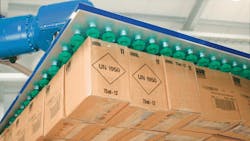Universal end-of-arm tooling (EOAT) from Schmalz lifts and transports multiple corrugated cardboard cases. The EOAT is available in many standard designs to handle a wide range of products and materials. This allows a single EOAT to handle varying size products, weights, pallet patterns, and full and partial layers, all without retooling for separate applications.
For example, corrugated cardboard has different vacuum requirements than air-tight sheet metal parts do. According to Bill Symanski, applications engineer for Schmalz, for an application handling porous products, vacuum generation must overcome air leak rate through the cardboard and through any uncovered cups. The leakage rate depends on the porosity, texture, and rigidity of the corrugate cardboard and the pressure differential (vacuum level).
Suction rates evenly distributed
Although each vacuum cup in this application is fed from a single port, check valves or flow restrictors at each cup evenly distribute the vacuum flow across the entire EOAT. In addition, the check valve or flow restrictor limits the leakage from uncovered suction cups. Vacuum testing and simulations are done to size these components. The check valves or flow restrictors are provided for every individual cup. Schmalz also applies this technology to its line of foam grippers.
Keeping leakage in check
Symanski explained that if a vacuum cup is covered by a work piece, it creates a seal. However, if a cup is uncovered, the resulting high air flow will cause a ball inside the check valve to move upward to seal the inlet. This will stop air flow through the uncovered vacuum cup, thus eliminating the leakage that would otherwise result. Because gravity holds the check valves open, inertia or inverted orientations can cause them to close unintentionally. Therefore, their use must suit the application.
Metered orifices: a simple solution
Symanski said porous surfaces offer another challenge. The air flow through some corrugated cardboard can actually be high enough to close the check valve even if the cup creates a seal on a surface. To solve this problem, Schmalz uses a flow restrictor — a metered orifice — at each vacuum cup. Each restrictor is sized to evenly distribute the flow and vacuum level across the entire end of arm tool.
System designers must allow for enough flow to handle the porous product while also providing enough restriction to limit the leakage from uncovered cups.
“We size this in the fractions of a millimeter, as these small increments can have a large impact when you are using 500 to 1000 cups on a layer gripper,” Symanski said. “From our testing and simulations, we have a good understanding of the flow characteristics of these metered orifices and use this to size the vacuum generators, valves, filters, hose, and connectors. Our flow restrictor design is a simple, very effective solution.”
Contact Bill Symanski, Applications Engineer, at (919) 713-0880 or visit www.schmalz.com.
About the Author
Ken Korane
Contributing Editor

Leaders relevant to this article:

